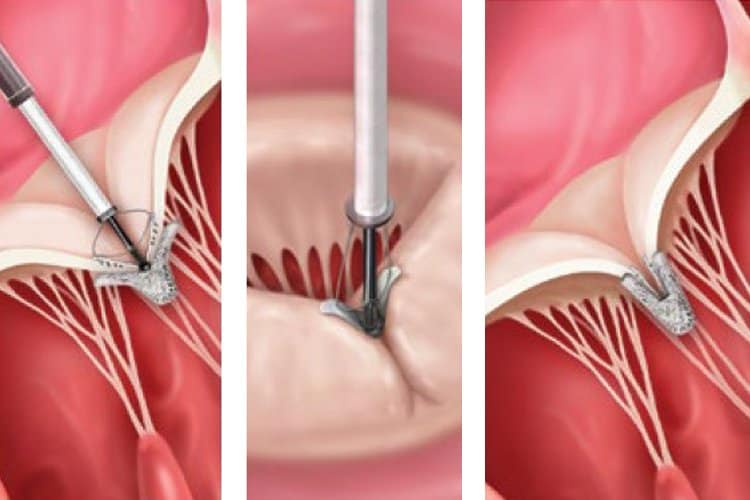Transcatheter Edge-to-Edge Repair (TEER) of the Tricuspid Valve
What is TriClip?
The TriClip™ procedure is a minimally invasive way to repair the tricuspid valve without the need for traditional open-heart surgery. The TriClip device is a small polyester wrapped metal clip which is inserted via a catheter through an artery in the groin and guided inside the valve while the heart is still beating. The catheter is guided to the heart using X-ray and ultrasound while the patient is under general anesthesia. This minimally-invasive treatment was designed for patients unfit for open-heart surgery. Once in place, the clip brings together portions of the leaflets (flaps of the valve), improving the seal and reducing the leaking. During the procedure, an interventional cardiologist will place the TriClip device on two or more of the tricuspid valve leaflets. These valve leaflets are like the little doors that open and close to regulate blood flow through the valve. By reducing the leakage, the TriClip helps restore proper blood flow and eases the strain on the heart. While the TriClip reduces tricuspid regurgitation, it does not completely eliminate it. The tricuspid TriClip device received FDA approval in April 2024. This procedure is the fourth advanced structural heart procedure that MyMichigan offers as a part of its robust structural heart program started in 2016 with transcatheter aortic valve replacement (TAVR).

About the Tricuspid Valve
The tricuspid valve is one of four valves that control blood flow through the heart. It separates the upper and lower right chambers and is crucial, allowing blood to move from the heart to the lungs. If this valve doesn’t seal fully when it closes, some of the blood will flow backward within the heart instead of moving forward to the lungs. This can force the heart to work harder and cause a range of debilitating symptoms. Patients with tricuspid regurgitation are extremely high risk for any type of surgical intervention, so historically they have just been monitored and treated with diuretics.
Symptoms of Tricuspid Regurgitation
While a patient may not notice any symptoms of tricuspid regurgitation until the condition is severe, symptoms may include:
- Noticeable swelling in your abdomen, legs or neck veins
- Extreme tiredness or fatigue, especially during physical activity
- Shortness of breath, especially during activity
- Abnormal heart rhythms, including feelings of the heart beating too rapidly or irregularly
- Pulsing in your neck or pronounced throbbing in your neck veins
If left untreated, tricuspid regurgitation can lead to progressive congestive heart failure, heart enlargement and early death.
Diagnosing Tricuspid Valve Regurgitation
In addition to a thorough patient evaluation, a variety of diagnostic tests may be performed to help diagnose tricuspid valve regurgitation.
- An echocardiogram to view images of the heart’s structure and function.
- A chest X-ray to see the size and shape of your heart and evaluate your lungs.
- A transesophageal echocardiogram to get detailed 3-D views of your tricuspid valve.
- A cardiac catheterization to obtain an image of the blood vessels supplying the heart.
How the TriClip Procedure Works
This short animated video demonstrates how the TriClip procedure works.
TriClip™ is a trademark of Abbott.
